
I did a team sealed recently and the deck I piloted was an Isochron Scepter deck. I don't run Scepter in cube that often as it is a little narrow and somewhat outclassed by planeswalkers a lot of the time. That said, it is in at the moment and worked a charm in my list. Our pool had lots of sac lands and fixing but very limited options on archetype. When building it I was under the impression that I was making the best out of a bad situation but the results might suggest more I was actually starting with a good situation.
While it isn't the best cube list for a Scepter deck I have had it was pretty close and given it was sealed rather than any other format I should have known to expect good things. Scepter decks are likely my best understood archetype, certainly most practiced. I played it for a whole extended season to decent success which I have never done before or since preferring to pick my deck for the specific event. By playing one deck so consistently I got very comfortable with knowing what risks to take, when you needed to throw out a vulnerable Scepter, when you can afford to wait for a more assured one, when you need a specific thing on the Scepter to win, when you can throw it down with any old thing just to get some value, when to play as a combo deck, when to play the aggressor and when to play as control.
Usually I stick 3 colours but my mana was so good and my team mate was going Gruul so it seemed rude not to toss in a dash of a 4th colour. I was going to do a fairly standard deck analysis of my list but when thinking about how I would do it I figured it would be more relevant and more interesting to do it as a list of the best cards to have imprinted on a Scepter and why. It is also more interesting for me to consider the various new options to place under a Scepter that have been printed in the period Scepter was absent from the main cube. This was the result of Unexpectedly Absent, one such new card that I have not had the joy of repeat casting until now. It is a great card in it's own right, fits well in this archetype and broadens your combo. It was so powerful in the deck I wanted to make sure there were not many other sleeper cards like this that I should get Sceptering! Just for reference here is my decklist. There are some imperfect solution cards in it I would rather were other things and it is missing a few things like graveyard reuse that would have made life easier but otherwise it is a deck complete with all the things it needs. After it we shall start out list which is looking like a top 12 for best imprint targets for the Scepter.
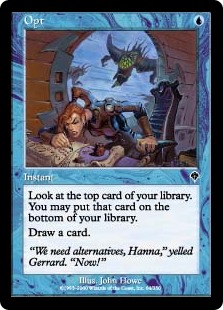
24 Spells
Chrome Mox
Opt
Swords to Plowshares
Orim's Chant
Vampiric Tutor
Isochron Scepter
Fire / Ice
Negate
Mana Leak
Lightning Helix
Impulse
Lat-Nam's Legacy
Unexpectedly Absent

Stoneforge Mystic
Squelch
Vendilion Clique
Kolaghan's Command
Toxic Deluge
Detention Sphere
Day of Judgement
Force of Will
Batterskull
Elspeth, Sun's Champion
Dig Through Time
16 Lands
Top 12 Best Scepter Imprintees
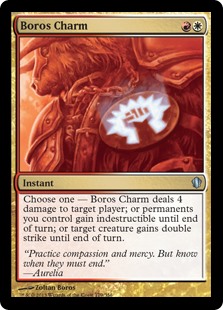
12. Boros Charm
There are lot of RtR Charms and DtK Commands that you can put under a Scepter but that have not had that chance yet in my cube. While all of these cards offer a lot of utility and power very few of them work well with Scepter. Dromoka's and Atarka's Command are incredibly powerful however they have some problems when considering them for a Scepter. A lot of the utility on these kinds of cards have diminishing returns. Rarely will you get to usefully kill an enchantment each turn for example. The other issue is that they require creatures to get the most from them and while you may well pack some creatures in your list you will not have a high enough density of them to be pumping and fighting with them in an efficient way.
Although seemingly less powerful cards the RtR Charms are on the whole a lot more useful in an ongoing capacity under a Scepter. Dimir and Izzet are pretty similar, both have a mild card quality option, an annoying situational counter and some equally situational removal. Both these Charms will do a usefull thing regardless of situation while rendering a lot of cards in your opponents deck pretty useless. They will be at their best against decks with higher counts of smaller dorks but never actually bad. The problem with these Charms is that they are not that powerful in their own right. Nice useful little cards but when in your deck they do noticeably reduce the overall power level.
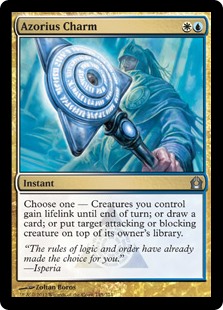
Azorius Charm is likely the best Charm not on this list for a Scepter target. The draw option is better than the card quality of the Dimir and Izzet Charms and the removal option scales well with repeat use and is effective against big and small things alike. It is just a much better control removal effect. Lifelink isn't going to scale well with your deck of low creature counts but it is a very significant extra tool that will go a long way in certain matchups, more so I would say than having an on the board Spell Pierce. Azorius Charm works against control with the removal and ongoing card advantage well and against aggro well too with the removal and lifegain potential. While it is certainly worth it in a Scepter deck the problem remains with Azorius Charm that it is just a very low powered spell when you are using it not under a Scepter.
Of the ten Charms it is Boros that came up looking the best of the bunch despite almost only having two abilities. The main difference between Boros Charm and the rest of the cycles is that it really is a powerful spell for the mana. Four damage at two mana instant speed is an awful lot, it will kill planeswalkers, finish off players ahead of time and represent a really serious threat when imprinted. Damage, like creatures, is something that is never a dead effect so you always have something you can do with the card. Indestructible is also immensely powerful despite being very situational. I love it most as a beyond rude counterspell for things like Armageddon and Obliterate! It might have use in protecting your own guys through either players Wrath effects or just being a more fair counterspell verses spot removal. What really makes Boros Charm interesting to a Scepter deck is not so much the fact it is an good finisher on a Scepter but that it protects the Scepter itself. You can do this a bit with a Counterspell but you are not then being proactive with your Scepter. With Boros Charm under it you can shoot them at the end of their turn or whenever they tap out ending the game fast while remaining very safe to removal. All told it is quite a frightening finisher that has a similar feel to it as True-Name Nemesis.
Doublestrike in a control deck should rarely be of any consequence, four direct damage is usually going to be safer and higher. You might get a good deal out of doing it to a Wurmcoil or Baneslayer angel or you might kill off some blue dorks with the Phantasmal Bear mechanic but mostly it is blank. In a constructed deck with 4 copies of Scepter this would be far higher on the list as it works so well with that card specifically. The reason the Charm only just makes the list despite it's power is that it isn't a generically good control card. It is not the best answer to a planeswalker and the other modes are generally late game and overly situational for the control style.

11. Diabolic Edict
This is just one of the best and safest removal spells to have under a Scepter. Every turn it will kill a creature and ultimately ruin a lot of decks. Edicts have reasonably good scaling compared to other removal with repeat use. Exile is a little better on average than forcing a sacrifice however exile does nothing to hexproof, protection and shroud dorks. Edict will cover you where other cards do not and it is fine in any kind of matchup. Agro decks simply have to go super wide, it puts them under a lot of pressure and will win the game for you if it stays in play too long. Control decks don't have lots of threats and so playing round Edict is a real pain for them. Token generation is a bit of a problem for Edict but still, you can't have everything. Between the white one mana instant exile removal and Edict you have yourself as best covered against creatures of all flavours as can be.
Creature kill in general is not the main thing you want to be doing with your Scepter. It will be right often enough in certain matchups to just throw your removal spell under the Scepter and try to grind out a win but it is not optimal. Ideally you cast your Wraths and removal allowing you to lock down the game or win the game with your Scepter. Using Scepter for card advantage and stall is great but it means you have to find another way to win which is not always as easy as it sounds for the archetype.
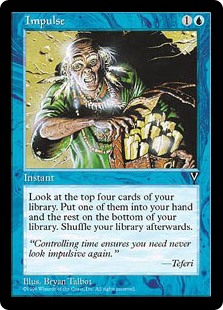
10. Brainstorm / Impulse / Lat-Nam's Legacy
These effects under a Scepter are fine but not ideal. Planeswalkers are just much better tools for this kind of thing. You are generally better off getting card advantage through your Scepter actively by removing permanents or countering spells. Doing this puts less pressure on your other spells. If all you are doing is drawing spells with your Scepter then you still have to draw and cast the things you need to deal with the situation at hand. Broadly you are playing cards like these in Scepter decks so that you can find the good things to put under it. You might be running other combo style things or miracles etc which increases the value of these already powerful cards. This is all well and good but it doesn't mean you want them under your Scepter. Pretty much any Jace offers better ongoing card advantage as well as more utility. The matches where you are getting beaten up are the ones where you least want a card advantage tool that costs you mana and has no tempo effect so the fact that they can't attack a Scepter and they can attack a Jace is not that relevant. Basically you put one of these cards under a Scepter in slow matches where you have already used a high number of your other good Scepter targets or you expect your opponent to have good solutions to your preferred Scepter targets. It happens quite a lot because these kinds of cards are really good on their own in Scepter decks and then the appropriate situations arise for you to use them together. It is an event of convenience and making the best out of an imperfect situation rather than a desired outcome. I am not saying it it bad, you will win most games in which you get to cast one of these spells every turn at no card cost, it is just far from optimal given the potential for the Scepter and the way in which the deck is designed to operate. A good comparison might be using a Deathrite Shaman to gain 2 life in your Reanimate deck so as to survive another turn against RDW but having to exile a valuable recursion target to do so. It is right in the situation and a good bit of extra utility to have but it harms the intended operation of the deck.
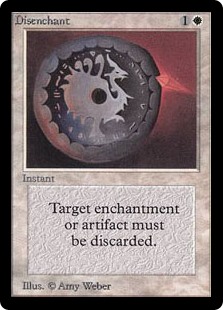
9. Disenchant
Possibly I am overrating this based on my memories of combo rife cube and extended formats. Certainly there are a lot of decks where this would be a real waste of a Scepter. Scepter decks can lock out a lot of different decks but they do struggle with certain types of card. Things like Sulphuric Vortex or Cursed Scroll that just sit there and apply pressure without needing to attack or do all that much. Scepter decks want access to a wide selection of removal so that they can eliminate the few key things that wreak them. As a result I love to have a Disenchant in my list, at worst I can shuffle it away or put it under a Mox. Then, every now and then you find yourself against a deck like Affinity or some combo deck relying on a couple of enchantments or something that simply can't win through Disenchant on a stick. That is a clear overstatement about affinity, that deck can win through anything but still, your win % increases very significantly with Disenchant on a stick, more so than any other removal spell improves it. Disenchant is a fine card to maindeck in cube regardless of what you are playing, the fact that it has two quite useful extra applications in a Scepter deck make it quite desirable. There are alternatives that can be better situationally but overall this is the safest and broadest one. White ones are much better than green because generally green has bad synergy with Scepter decks and no other interesting spells to put under it.
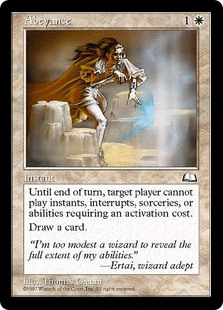
9. Abeyance
Abeyance does nothing against people making creatures and inserting them into your face which is the main way people win games in magic. It annoys the hell out of control and can wreak a lot of combo decks however. It also isn't the worst against a planeswalker heavy midrange deck. The real advantage of Abeyance is that it draws a card hence making it a more reliable thing to put on a Scepter than a Disenchant and a more useful thing to put on it than one of the card quality cards. The cycling also makes it less detrimental on your maindeck than some of the cards in this list. It is great to have the option on an Abeyance in a Scepter deck and having it doesn't hurt your consistency. The problem in cube is mostly that of space, finding something you can do without in your list so as to put in the Abeyance.
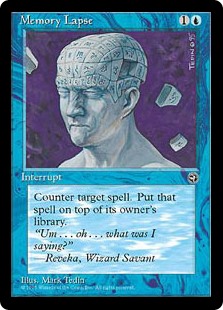
8. Memory Lapse
While not exactly high on the list Memory Lapse is the second highest Counterspell on the list. While at first thought a Counterspell on a Scepter might seem like a brutal thing it is actually very easy to play around. You can easily play through it and not wind up behind. Do not forget that in order to get a Scepter running you have to two for one yourself. That means even when you go two for one with your Scepter you are still even overall. You can make a Counterspell Scepter, I can unload some spells into it of which you stop one. You are two mana worse off than just having countered my spell and you have a Scepter to show for it which might not come into play again if the spells that slipped past were enough to take down the game.
Scepter is either skipping a turn or it is at least a 4 mana card. Most of the time an aggro deck will be in a position to kill you without needing to play anything into your slow Scepter. In such situations you are far better off just countering anything they play without skipping a turn and waiting for something that can effect the board to imprint. Against slower decks the Counterspell stick is a more viable option but mostly all it does is slow down the game. People will either save up for one big turn where your Scepter offers no advantage over just having the spell in hand or they will bait you into using it on something weak so that they might have the option on casting a relevant spell past it. If you let enough Llanowar Elves resolve they will end up killing you! Rarely do you get both value and card advantage at once from a Counterspell on a Scepter. The other thing is it kind of locks down two of your own lands so you can't do that much either. You also have to play a little safer than normal because just getting your Scepter blown up represents far too much of a loss. As such you might well be locking down four land and sitting on a counter in hand waiting to have enough lands to do something else.
Memory Lapse is significantly better on a Scepter than Actual Counterspell for two reasons. Firstly it really punishes the player who tries to bait you into using it by playing out weak cards. By hitting weak things with Lapse you lower the quality of your opponents draws. This forces one of two plays, either make at least two relevant things a turn and bleed tempo and card advantage into the Scepter in the hope of killing them before you run out of gas. The second play is the waiting game where you hold out till the one big turn. The problem with this is that it only works if you have lands to make, if you are not making lands you are not increasing your potential to have a big turn all the while running out of room in the hand. The baiting play of making weak things is even worse in such a situation as you will not only get a weak draw next turn but a non land at that. Essentially, in the right situation (which is just not too far behind on the board) a Memory Lapse on a stick will force your opponent into playing a certain way. Because they are so limited in their options you are able to prepare and counter them with much greater ease than you would with other kinds of counter magic. Memory Lapse punishes land light draws a lot. It also punishes floods all be it not quite as hard. It punishes expensive decks and decks that lack high numbers of relevant spells. It will not win the game on its own but it will give you all the time, information, tempo, card advantage and control to do so by other means.
Memory Lapse on a Scepter acts much more like a hard counter than it does when just used as a one off spell in a deck. Unless your opponent has ways to draw extra cards and the mana to do it all you can perpetually keep someone from casting any sorcery speed card. When a good card has some bonus positive synergy with Scepter then it is much more reasonable that it can overtake "better" standalone cards that do similar things. Another significant perk of the Lapse is the resource denial aspect either just used once or repeatedly. Scepter decks inherently intend to obtain recurring value, they are also fragile to some things. You are much safer and in control the less able your opponent is to do stuff and the less options you leave them with. Memory Lapse is perfect for this, it denies your opponents resources in a way other Counterspells don't and in a way that really suits what you are doing. You can save Memory Laspe to specifically disrupt a big turn or spell in the same way you do with other countermagic in the non tempo matches. You can also just throw Lapse at anything they cast should you want to be spending your mana usefully. You can use it as you might a Remand except that it will generally be better in the deck than Remand.
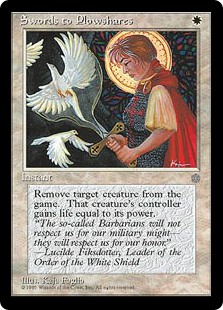
7. Swords to Plowshares and Path to Exile
The premium removal cards and the ones that are most likely to ruin aggro and midrange decks. You can wind up giving people a lot of land or life but there is significant diminishing returns on both and neither are relevant if they can't actually kill you. One of the best games in cube I ever had involved me living forever where I shouldn't have done due to a Swords on a stick. It took a long time to recover and many other cards beyond the Stick and my opponent was around 60 life better off. I managed to just win the game in the upkeep of the turn I would deck myself after several turns of throwing all my red mana into Lightning Bolt over and over again having managed to ultimate a Timayo. Path and Plow are great in any deck and against most other decks. You usually want more of them that is for sure and with Scepter that is a thing you can have. They are not always the way to go in a game as an imprint target but they are the way to go a lot more than Disenchant is. Being able to significantly effect the board and recover from behind with them helps a great deal. It is not exciting, it is not always enough and it is not for every matchup but it is a great thing to be able to do and the cards are just so good that it really shouldn't come as any surprise that they are so powerful cast again and again for twice the normal cost. Unlike versus countermagic you cannot save up for that big turn, you just have to kill the Scepter or lay guys into it hoping to not run out of guys before you get them to zero. If your opponents game plan is to kill you with creatures then creature removal is far far better than countermagic or card advantage on a Scepter.

6. Arcane Denial
The best counter to have on a stick because of its versatility. It is a cheap and hard counter so a fine thing for a control deck, it will be good when not on a stick and support whatever is or intends to be as well as a card can. As a Counterspell on a stick it is worse than Counterspell or Memory Lapse because it gives your opponent gas. This is acceptable, it just means you have to use it only on the relevant things and not just any old spell. The reason it is good is because you can turn any spell you don't want into 3 cards by countering your own stuff. Most commonly this is Chrome Mox but Disenchant gets a fair bit of self countering too. This large draw influx can be used to offset the gas you give your opponent while also putting your Scepter to use when it might otherwise be idle as counterspell Scepters so often are.
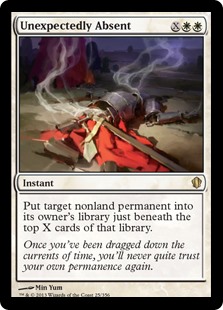
5. Unexpectedly Absent
Somewhere between a Boomerang and a Memory Lapse. Absent has a great advantage over Lapse in that it can reactively recover a bad board position. It also has the advantage over Boomerang that you cannot just recklessly play as much as you can into it as you will run out of gas should you not quickly kill them with what you have. Absent also has a couple of the flaws that both Lapse and Boomerang have making it comparable rather than directly better. Like Boomerang you cannot effect spells or things with highly powerful enter the battlefield effects at all or effectively with the Absent. Like Lapse you are able to play around an Absent by not having any targets for a few turns so that you can build up some resources and throw them out all at once. Absent on a stick is game over for midrange if they don't have an answer and it is bad for aggro and control as well. You lose the X utility of the spell but it is minor when you can spam it. It has the advantage of not always being obvious how to play around it or change up your tactics which is not the case with Boomerang. Weaker players will fold to this pretty hard.
4. Boomerang
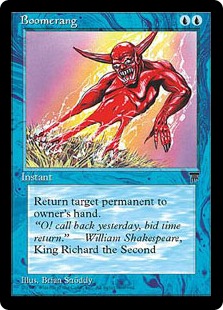
Boomerang on a stick is all about how quickly you can get it going. It is basically good games against everything if you make it turn one with a Chrome Mox. The later you go into the game the weaker it gets. Boomerang scales in power with your opponents mana, the less they have the better it is. Late game they should have lots and be able to easily recast all the things you bounce somewhat overwhelming you. Because it can target lands however you cannot play around it, you will always have targets and so you have to play through it. If you can't do this it will start to bounce your lands and increase its own power. Obviously control are weakest to Boomerang every turn with midrange being next weakest to it and aggro being the most capable of plowing through. Control is weak as it has few permanents, a bigger top end of curve and a greater reliance on making another land each turn. Another mild perk of the Boomerang stick is that it can self protect, you use it at end of their turn to bounce something (ideally land) when you fear removal so that if it comes you can bounce the Scepter instead. You won't be able to put the Boomerang back under it but you will at least still have it for your other imprint targets.
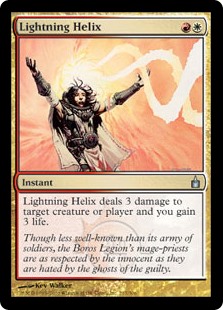
3. Lightning Helix
It isn't exciting but it is fairly effective. It is also one of the best thing you can do against most aggro decks and the best thing to do against the red ones. Helix is so much value and broad utility in one card that you can't go wrong with it on a stick. Just taking a 6 point life swing every turn is going to win most games in which you do much of anything else. Helix will kill most creatures in the cube, it really limits planeswalkers, it is very hard to race and it is never dead like Unexpectedly Absent or Counterspells can be. It is best versus the creature based decks not only because it increases your options on how to use it but because the decks without creatures are more able to endure the life swings and still win through card advantage. Unless you are killing things with Helix you are not advancing the board or gaining card advantage. A great combination but significantly better in some situations and matchups than others. It might not end the game as fast as a Boros Charm but it will offer a stupendous amount more safety along the way to doing so than a Boros Charm could. It is also a much more playable card in general than most of the others in this list.
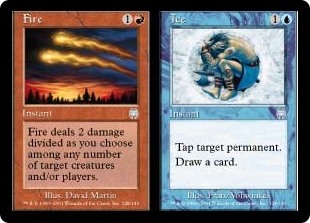
2. Fire / Ice
Remarkably for once we find the mighty Fire / Ice not at the top of a list in which it is a contender! Fire / Ice on a stick is the never bad utility and value option. It is rare to outright win the game through the combination but it is an immense boost to any strategy and against any strategy. The tap and draw function is the preferred as it fuels you with the cards you want to win the game with rather than just controlling it. Ice on a stick is like having a Rishadan Port combined with a perpetually active Library of Alexandria in the control matches. This doesn't take at all long to gain a solid lock on any such game. The more aggressive your opponent the more you will need to be using Fire to control the board. Although Fire is a fairly weak removal spell as the game goes past the early turns the ability to Ice things too big to burn makes up for this a lot. Fire / Ice is the best thing to stick on a Scepter if you have no idea what you are facing against, situationally other cards will be a little better but Fire / Ice is always at least good. It gives value, options and control, most other cards you can imprint give two of those things at best.
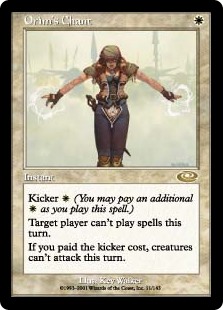
1. Orim's Chant
Even in the diverse and powerful cube an Orim's Chant on a Scepter is literally game over against well over 50% of the decks in the field. Do this with a Force of Will backup or survive long enough to do it later on with other counter backup and it is game over against over 80% of any given cube meta. A fourish mana two card combo compares pretty well against some of the best combos ever used in magic. Because it doesn't win the game itself it is unlike the more conventional combos like Painters Servant / Grindstone you find you want to house it in a control shell more than your more typical combo shell. You want stall and answers rather than speed and disruption. Only instant speed things and permanents that can win a game without attacking do much of anything against an Orim's Chant on a Scepter, This means most midrange decks have a couple of cards at best that are in any way relevant to you should you have the combo. Only aggressive decks that have a lot of instant burn have much game against you, they have to win before you can find your things and that is their best shot. Only combo decks that can win at instant speed such as storm pose any threat and given how potent Orim's Chant is against storm you just have to play a little differently with your cards, generally a responsive Chant rather than a proactive one. Only RDW and control decks with instant removal and countermagic give you cause for concern but this is why you have things like Boomerang and Lightning Helix as alternate Scepter targets that do a lot more work than Chant in those few matchups. This is why this archetype is still so good in cube, it has too many free wins in the meta while not actually having any directly bad matchups. It is quite easy to counter the deck and post board it is a lot weaker but this is only the case should you have the things available to you. Most cubes do not run that many great sideboard cards.
In cube hand disruption is the best way to beat a Scepter deck but it needs to be backed up by a good deck. Cheap countermagic and things like Brainstorm and graveyard recursion make you a lot safer against hand disruption. What I see as the problem for this deck in cube is not how powerful it is but how narrow it is. Neither Scepter nor Orim's Chant are at all broad in their use. Chant is much more of a sideboad card than a maindeck sort of thing if you do not have a Scepter for it. Likewise Scepter only really goes in a deck like this and is a whole lot less exciting if you don't have the potential for it to be a win move due to not having the Chant. Scepter is fine with all the other cards on this list, even good in the right situations but the point remains that you can get more value and utility with more consistency and less risk just by playing planeswalkers instead. Since starting this article a few months ago I have already cut both the Scepter and the Chant from the cube. It isn't fun to play against and they are simply too narrow to deserve valuable cube slots.